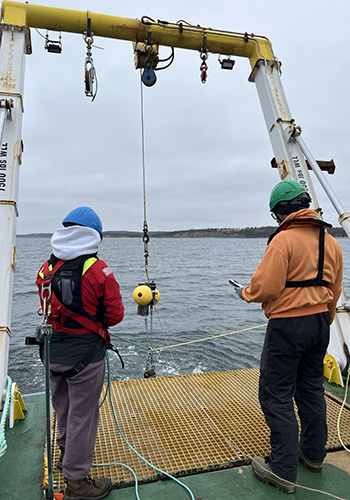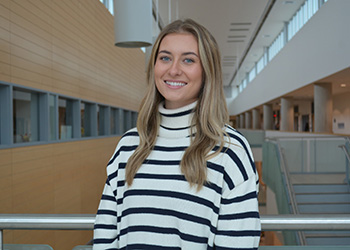A day in the life: Emma
Get to know Emma, an Oceans Technology student
Name: Emma
Program: Oceans Technology
Campus: Ivany Campus
Class: 2024
Why did you choose to study in the Oceans Technology program?
After completing an undergraduate degree in Biology, I always had an interest in the ocean sector and wanted to further my education. I came across the Oceans Technology program and thought the description of the program would be well suited for myself.
Out of this program, I wanted to gain more hands-on experience in field settings as I found that lacked in my university career. This program was great to diversify my skills and give me hands on technical experience.
What's your favorite part of studying at NSCC?
The smaller class size was an advantage in terms of learning and having one-on-one interaction with my teachers. This made it easy to ask questions and fully understand the material we were covering.
I had a positive experience at Ivany Campus and the teachers involved in the program did a great job at making the class material exciting yet very educational.

What does a typical day look like in the Oceans Technology program?
A typical day can include a combination of hands-on applications with marine instrumentation while also incorporating sit down lectures on related material. This program is diverse and every day looks a little different!
Classes run Monday to Friday, 8:30 am until 3:30 or 4:30 pm. This program incorporates an abundance of field days relating to course material, providing a good balance of classwork and fieldwork.
What kinds of projects and assignments do you work on in Oceans Technology?
A few examples of the kinds of projects and or assignments that are completed in this program are:
- mooring assembly
- deployment and recovery
- working on a variety of marine instrumentation and the compatible software
- creating BRUV (baited remote underwater video) systems to deploy and recover
- a week on a vessel collecting marine data mimicking offshore work settings
- photography assignments working with Nikon cameras
- navigation classes understanding various programs (such as Winfrog)
- working with electronics completing projects such as soldering, building battery packs and temperature loggers
What types of tools or equipment do you use?
A wide range of hand tools, marine instrumentation (such as conductivity, temperature and depth or CTDs, transducers, transponders, ultra short baseline, acoustic doppler current profiler, acoustic zooplankton fish profiler), soldering tools, drill press, three different vessels for water operations, Van Veen sediment sampler, zooplankton net – and many more!
What’s your plan after you graduate?
After I graduate from this program, I hope to begin my career in the oceans sector continuing to apply my skills I developed from the program while enhancing my knowledge from industry experts. I am currently completing my internship with a focus on product assembly. In this sector, there are many different career pathways you can pursue, and I am looking forward to trying out different roles to see what suits me the best!
Do you have any advice for someone who might be interested in taking this program?
For future Ocean Technology students, the one piece of advice I would have for the program is to ask questions! Over the span of the year, this program covers a wide spread of material ranging from electronics to operating vessels. Ensuring you understand the material before going into the field and applying your knowledge is very helpful.

A day in the life – Oceans Technology field experience: Halifax Harbour excursion
Morning
6:30 am - Wake up and prepped notes for the day ahead, planning responsibilities and goals for the day.
7:30 am - Breakfast.
8:15 am - The vessel began to go underway to our first location to begin deploying mooring 1 of 7.
8:30 am - Began prepping the three moorings my team was responsible for deploying. This included testing the instrumentation battery was sufficient, the storage was cleared on all instruments, they were operating properly and checking that the mooring was assembled properly. This was also done the night before, so this morning check was a quick conformation the moorings were prepped for their 8-month deployment.
11:30 am - My team completed deploying our three moorings, so we took a break and ate some lunch.
Afternoon
12 pm - Took a shift in the navigation room noting the time, depth and location (latitude and longitude) of each mooring deployment. In this room we had video surveillance of the back deck and communicated via radio.
3:30 pm - For the last mooring deployment a few students including myself switched to NSCC’s Rosborough vessel to complete the last deployment.
Evening
5 pm – 8pm - Did some evening ROV operations for students in the class to test their capstone projects.

